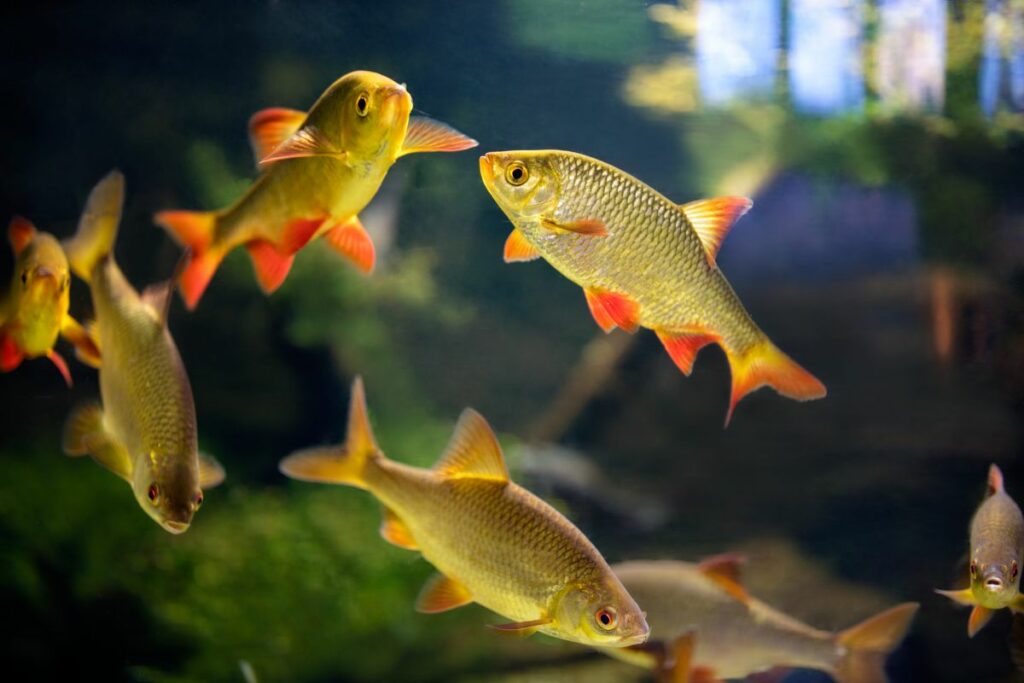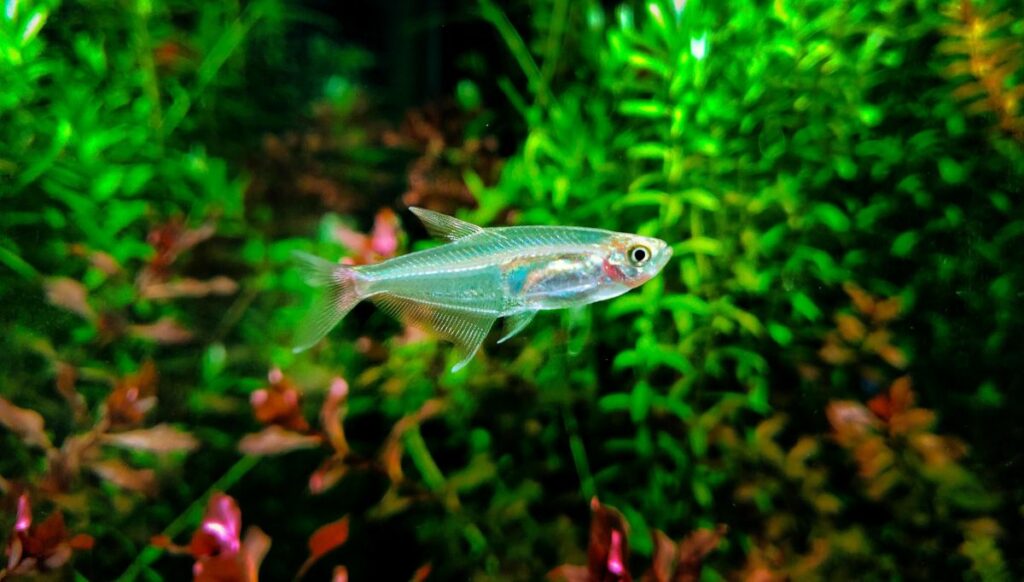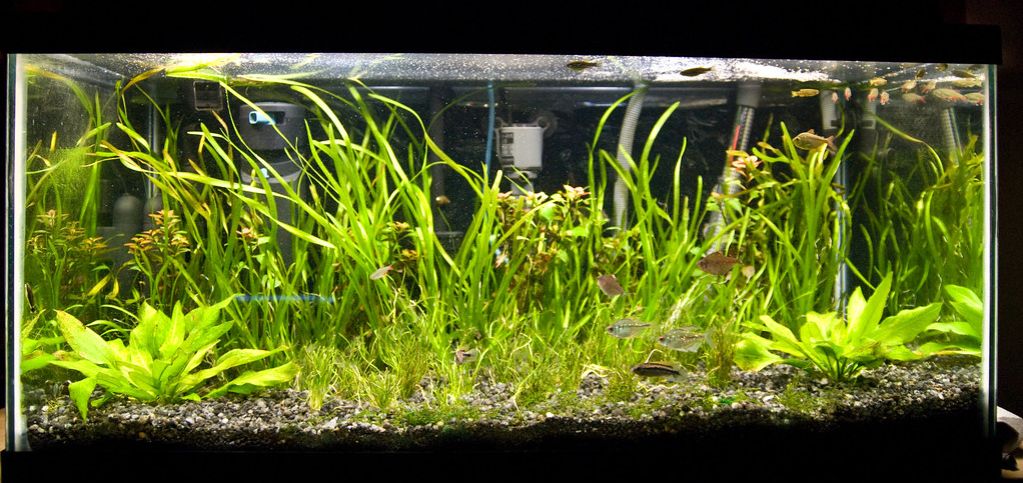Bloodfin tetras are underrated in today’s aquarium hobby, where brillant neon colors are what people favor. But few tetra fish are so hardy – or as long lived – as the bloodfin tetra. What makes these fish so good for the majority of community aquariums?

What is the Bloodfin Tetra?
One look and it’s easy to see how the bloodfin tetra gets its name. Both males and females have a ruddy patch of blood-red color along the anal fin. Depending on the health and age of the fish, the red will also expand into the pelvic, dorsal, and tail fins.
Bloodfin tetras are often found when small in the pet trade. They grow up into medium-sized tetra fish at 2 inches, though.
Unusual for a tetra fish, bloodfin tetras are cold-hardy. They come from the Paraná River basin, which is somewhat far to the south, reaching the tropic of Capricorn. The subtropical zone starts here, where temperatures are cool in some seasons.
Bloodfin tetras are long-lived for small aquarium fish. 10 years is not unheard of, with 6 to 8 years being typical for healthy adults.
- Common Names: Bloodfin Tetra, Red Fin Tetra, Glass Tetra, Glass Bloodfin Tetra
- Scientific Name: Aphyocharax anisitsi
- Origin: Paraná River basin, South America
- Length: 1½ to 2 inches
- Tank Size: 20 gallons
- Temperament: Peaceful; Schooling
- Ease of Care: Very Easy
Bloodfin Tetra Care
Bloodfin tetra care is uncomplicated as they are hardy and not at all disease prone. They still need very low levels of nitrogenous waste. But glass tetras do better in a wider range of water temperature and chemistry levels than most other tetra fish.
Red Fin Tetra Tank Size

Bloodfin tetras will grow 1½ to 2 inches, making a 20 gallon tank the minimum for them. They are small fish but need to be kept in schools. Any fewer than 6 fish and they will be stressed and hide most of the time.
In the wild, you will find bloodfin tetras in schools of hundreds or even thousands of fish. So the more of them you keep together, the more confident they will behave.
20 gallon long aquariums work better than the high version since they have more length for swimming. Red fin tetras are fast, active fish that will utilize all of the space you offer them.
Plants and Substrate Choices
Like all tetras, bloodfin tetras do great in planted aquascapes. I would even say that live plants are essential for a tank with tetras. Plants offer a number of advantages for the tank and thrive in the same water conditions as the fish.
Plants create shade and cover, helping to control algae. Dimming the lights helps tetras feel more comfortable being out in the open. Their colors are brighter, especially when paired with a dark substrate.
Live plants also consume nitrogenous waste as fertilizer, which all tetras are sensitive to. Last, they provide bloodfin tetras a place to spawn. As egg scatterers, they seek out tangles of thick plant growth to deposit their eggs.
Good spawning plants include Java moss, guppy grass, and hornwort. Hornwort also pairs well with bloodfin tetras in unheated tanks and will grow rooted or as a floating plant.
For heated, tropical tanks, your plant choices are unlimited. Bloodfin tetras are carnivores and won’t eat plant growth. Amazon sword plants, Java fern, floating plants, and vallisneria are a few easy to grow plants that do well for beginners.
Gravel and sand are both suitable as a substrate for bloodfin tetra aquariums. These fish aren’t picky since they don’t swim near the bottom for long. Not unless there is uneaten food lying around.
Pick a dark substrate, if possible. Darker tank bottoms and plants encourage the fish to develop deeper red colors. You may even see subtle iridescent blue and green hues once the fish settle in.
Bloodfin Tetra Water Conditions
Blood tetra fish are some of the hardiest types of tetras in the aquarium hobby. They are more cold tolerant since they live further from the equator than their relatives.
Water temperatures as low as 64℉ are comfortable for them, with 82℉ being the upper range of their preference. A tetra temperature zone of 64-75℉ is best, however.
Water chemistry should be acidic to neutral (pH 6.0-7.0), but mild alkalinity (up to pH 7.5) won’t cause them stress. Any higher should be avoided, however.
Bloodfin tetras don’t need water as acidic as Amazonian tetras. But hardness levels (dissolved minerals) should still remain low to moderate.
Nitrogenous waste (ammonia, nitrite, nitrate) levels should be kept low. Ammonia and nitrite need to be at or close to 0 parts per million at all times. They are still sensitive to these pollutants and will be the first fish to stress or die if concentrations don’t decrease over time.
Nitrate levels of 10 to 20 ppm are fine if you have live plants. Plants need small amounts of nitrogenous waste as fertilizer. But levels beyond 20 ppm are stressful for blood tetras.
Bloodfin Tetra Tank Mates

Red finned tetra fish are peaceful, schooling fish. So once you have a small group of them established, it’s simple to add other community tank fish.
With one exception: bloodfin tetras are fin nippers. They aren’t being aggressive; the long, waving fins of other fish look like worms and other prey.
The tetras feel a feeding response when seeing them. So keep them away from long finned fancy guppies, angelfish, betta fish, and other tempting targets.
Any fish of similar size that thrives in the same moderate water conditions will do well with bloodfin tetras. Here are a few fish that will work as bloodfin tetra tank mates:
- Honey Gouramis
- Sparkling Gourami
- Platy fish
- Electric Blue Ram Dwarf Cichlid
- Kribensis Cichlid
- Cory Catfish
- Yoyo, Kuhli, and Dwarf Chain Loaches
For unheated, coldwater aquariums, zebra danios, rosy barbs, white cloud minnows, celestial pearl danios, dojo loaches, and red cherry shrimp are excellent matches.
What Do Bloodfin Tetras Eat?
Glass bloodfin tetras are carnivorous fish; better thought of as micro predators. They feed on zooplankton, insect larvae, baby fish, and tiny crustaceans in rivers and streams. Their diet should be protein rich, with minimal to no vegetable matter.
Bloodfin tetras will eat prepared flake and pellet based formulas. Choose micro pellets for these fish as their mouths are too small for anything larger. Formula diets should have little vegetable starch and other filler ingredients. Look for fish meal, krill, squid, and other high quality ingredients.
Supplement this base with regular offerings of live and frozen food. Brine shrimp are high in fat and carotenoids. Bloodworms are also rich in carotenoids, which help your tetras show even deeper blood red coloration.
Tubifex worms are good for conditioning them to spawn – but offer them a few times per week since they are high in fat. Feed bloodfin tetras two to three times per day, as much as they will eat in 2 to 3 minutes.
Breeding the Bloodfin Tetra
As long as you provide good water quality and a variety of foods, bloodfin tetras are going to spawn for you. They are easier to breed than other tetra fish; yet another reason why glass tetras should be more popular.
Sexing them is a little tricky but there are some visual differences. Adult male bloodfin tetras have small bony hooks on their pelvic and anal fins. They are also smaller and a little slimmer than females. But their colors are identical.
Male fish spend most of their time sparring with each other over territories. While females school with each other in peace.
You are better off building a separate spawning aquarium once your females start to swell with eggs. Unlike most tetra fish, bloodfin tetra eggs aren’t sticky and won’t be easy to harvest from plants.
They tend to drop straight down when laid. Some will nestle among plants while others will fall into the tank substrate.
For such small fish, bloodfin tetras lay a lot of eggs. 300 to 500 eggs is normal for a single spawning event. Once the eggs are laid, the parents ignore them. Or they may eat them if found. So best to separate the fish from their eggs.
Bloodfin tetra eggs hatch in 24-48 hours. The fry don’t need to eat right away since they have their yolk sack to sustain them.
After 48 more hours, they will be free swimming and looking for live infusoria to eat. Baby bloodfin tetras will be large enough to handle live brine shrimp nauplii after 7 to 10 days.
Conclusion
Bloodfin tetras aren’t as colorful as some of their cousins from the Amazon. But they are hardier, easier to breed, and longer lived. Glass tetras add a splash of color to unheated aquariums. And they are peaceful towards their community tank neighbors.
FAQs
No, they aren’t. Tetras lay eggs and scatter them among rocks and plants. They don’t provide any parental care either, unlike cichlids and gouramis.
Bloodfin tetras are fin nippers. Angelfish, betta fish, fancy guppies, and other long-finned fish will be stressed by the constant biting. Choose bloodfin tetra tank mates with care.
Cardinal tetras (Paracheirodon axelrodi) are different from bloodfin tetras. They grow to be the same size but are more difficult to care for since most are wild caught. Cardinal tetras are not aggressive fish, nor are they fin nippers.

